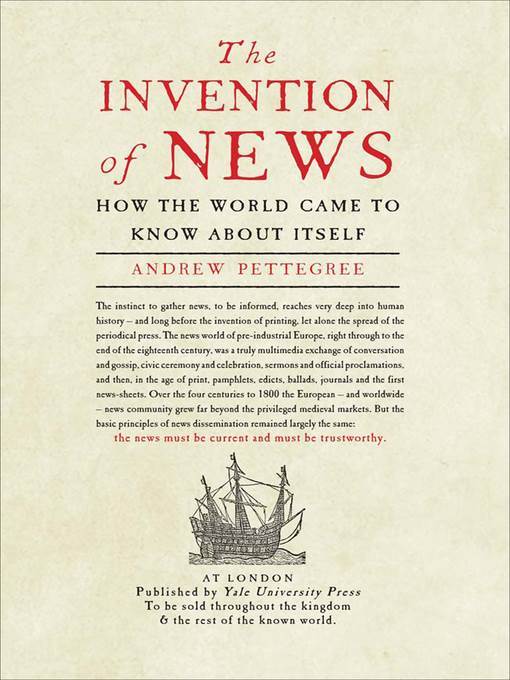
The Invention of News
How the World Came to Know About Itself
کتاب های مرتبط
- اطلاعات
- نقد و بررسی
- دیدگاه کاربران
نقد و بررسی

March 3, 2014
Pettegree (The Book in the Renaissance) delineates the history of news delivery in Europe over the course of four centuries in this comprehensive and occasionally dense volume. He tackles this ambitious task both methodically and confidently, charting the ways in which news initially traveled, beginning in 1450 with the years following the invention of printing. Publishers then experimented with pamphlets and broadsheets, new types of books that were "far shorter and cheaper than the theological and scholarly texts that had dominated the market in manuscripts." These helped to make news a part of popular culture. Pettegree attributes the early need for political and economic information to their roles in commerce. Merchants in 14th and 15th-century Italy, for example, had to obtain "vital data on which to base business decisions." They relied on it. "But to act on a report that turned out to be false, or exaggerated, could be more disastrous than not to have acted at all." Trustworthiness was key back then and continues to be a primary concern in journalism. Though Pettegree does not directly address parallels between the emerging news industry centuries ago and the complexities of mass media today, readers will recognize them. The similarities keep his discussion relevant.

February 1, 2014
From imperial messenger and town crier to Citizen Kane: a vigorous history of the rise of the news business. Who needs news, anyway? Well, writes Pettegree (Modern History/Univ. of St. Andrews; The Book in the Renaissance, 2010, etc.), first there is the potentate, who needs to know the doings in the far corners of the realm. Then there's the merchant, who needs to know conditions in distant markets, the better to buy low and sell high. The author first examines such fledgling news enterprises as the couriers of European rulers and entrepreneurs, who, it can be surmised, were not always trustworthy, given the advantage they found in controlling what news was released and when. He then turns to such pioneers as the curious (in both senses) Cologne burger Herman Weinsberg, who kept dossiers on his relatives and neighbors: "It was only after his death that his appalled family members discovered that he had memorialised all their doings in an expansive chronicle of their lives and times." Weinsberg also gathered accounts of political events, noting the importance of what emerged as a significant theme in Pettegree's book: the integrity of the teller. The author takes a refreshingly broad view of what constitutes journalism--he includes medieval balladeers in the mix, for "singing ballads was a powerful part of information culture"--and of the genealogy of problems that any old-school newspaperperson will recognize: from the proper balance of ads to editorial copy to making decisions on what to run and what to spike and, as always, reaching audiences whose members might not always have appreciated that they needed the news that was on offer. Was the newspaper an instrument of liberation or control? Can any news be trusted? Is the free flow of information essential to a democracy? Learned and well-written, Pettegree's book ventures fruitful answers.
COPYRIGHT(2014) Kirkus Reviews, ALL RIGHTS RESERVED.

Starred review from April 15, 2014
The desire and need to know what is happening in the world around us has deep historic roots. Pettegree (history, Univ. of St. Andrews) carefully documents the history of news in Europe. Beginning with the prepaper world, the author covers the four centuries up to 1800. As Europe developed, the start of a communication network formed to support the information needs of rulers, church officials, and developing commercial enterprises. Early efforts included papal courier services, a postal service for the Holy Roman Empire, and medieval chronicle writing. Previously, news was often delivered orally in town marketplaces, taverns, and churches, and only the elite could afford to subscribe to specialized manuscript messenger services. As print evolved, along came pamphlets, edicts, journals, and broadsheets. Then, when printing materials became cheaper and more accessible, people's understanding of the world began to change. The book is wonderfully illustrated with examples of early news sources. Pettegree relies on an impressive range of archival sources, including diaries, that illuminate how several individuals acquired and understood everyday events. VERDICT This expansive view of news and how it reached people will be fascinating to readers interested in communication and cultural history.--Judy Solberg, Seattle Univ. Lib.
Copyright 2014 Library Journal, LLC Used with permission.

























دیدگاه کاربران